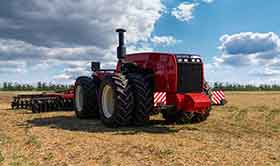 Master Bond pioneered the development of novel adhesives, sealants, and coatings, which are able to enhance the performance of autonomous machines. These unique compositions consist of epoxy, silicone, urethane modified epoxies, cyanoacrylates and UV / visible light curing compounds. Different grades offer advantages over mechanical fasteners such as bolts, screws, and rivets. They reduce weight, eliminate stress concentration, improve load bearing capacity, provide a protective barrier between surfaces that are susceptible to corrosion, bond dissimilar substrates, remove the need for drilling holes, augment durability/toughness, deliver superior fatigue resistance, and are aesthetically pleasing.
Master Bond pioneered the development of novel adhesives, sealants, and coatings, which are able to enhance the performance of autonomous machines. These unique compositions consist of epoxy, silicone, urethane modified epoxies, cyanoacrylates and UV / visible light curing compounds. Different grades offer advantages over mechanical fasteners such as bolts, screws, and rivets. They reduce weight, eliminate stress concentration, improve load bearing capacity, provide a protective barrier between surfaces that are susceptible to corrosion, bond dissimilar substrates, remove the need for drilling holes, augment durability/toughness, deliver superior fatigue resistance, and are aesthetically pleasing.
Selecting the proper adhesive system for the assembly of autonomous equipment is contingent on compatibility with the substrates being bonded and the environmental exposure of the mated joint. Master Bond products can be dispensed manually or via automated means, and many provide rapid cure times, increase productivity, and superior adhesive strength. They are compounded to withstand high/low temperatures, thermal cycling, vibration, impact, and shock. Additionally, many grades protect against harsh chemicals, moisture, humidity, pressure, abrasion and are low outgassing. Thermally conductive, electrically conductive, or electrically insulative grades are available to adhere thin surfaces, irregular shapes, and complex/compact designs. Utilization of these systems can assist engineers in obtaining ambitious objectives for the construction of diverse autonomous equipment for factories. Some examples include:
- autonomous mobile robots
- collaborative robots (cobots)
- automated storage and retrieval systems (ASRS)
- automated inspection systems
- robotic arms
- automated guided vehicles (AGVs)
- automated assembly systems
- reduction of errors
- peak quality control
- optimizing output
- remote operation
- strengthen data collection
- bolster capacity
- ameliorate consistency
- upgrade accuracy
- work 24/7 without breaks
- diminish risk and injury
- autonomous cars
- drones
- autonomous forklifts
- earth moving equipment
- material handling equipment
- autonomous trucks
- autonomous vacuum cleaners
- autonomous boats
- autonomous trains
- autonomous municipal buses
- attaching heat sinks or other cooling devices to processors/power supplies
- bonding sensors to substrate to detect and monitor temperature, pressure, distance, acceleration, position, obstacle avoidance etc.
- sealing connections to prevent fluid or gas leakage
- adhering components to printed circuit boards (PCBs)
- EMI/RFI shielding
- gap filling
- securing cables and wires in place
- camera mounting to a machine's body
- attaching the frame and body of autonomous vehicles to withstand stress
- composite fabrication to create lightweight structures
- potting and encapsulation of electronic components for protection against dust, moisture, chemicals, vibration
- bonding different panels together
- battery pack assembly
- joining small/tiny components to larger structures
- enclosure sealing
- adhering windshields to frames for autonomous vehicles
- surface coating for protection against wear, tear, corrosion and to bolster appearance
- actuators
- control systems
- power sources
- communication systems
- sensors
- navigation systems
- computer hardware equipment
- safety systems
Deploying these formulations can result in major benefits such as:
Among the most acclaimed industries for autonomous equipment are:
Master Bond adhesives, sealants, and coatings are recommended for a wide variety of specific production applications. They are often employed for:
Master Bond adhesives are known for their versatility. Different grades are frequently used to bond an assortment of metal, plastic, composite, and ceramic substrates. Careful evaluation of many factors is essential to verify the effectiveness of the adhesive chosen. It is mandatory to perform proper surface preparation to achieve the best results. Common materials capable of achieving the necessary properties to meet precise specifications may range from ABS, polycarbonate, nylon to steel, aluminum, titanium etc. They may also involve carbon fiber reinforced polymers (CFRP), glass fiber reinforced polymers (GFRP) to alumina, and zirconium. Manufacturers of this equipment depend on excellent strength, consistency, durability, and dependability to make certain that operation in service is flawless.
Particularly noteworthy is that Master Bond plays an integral role in producing compounds for components that are imperative for running disparate autonomous equipment during arduous circumstances. They are comprised of:
